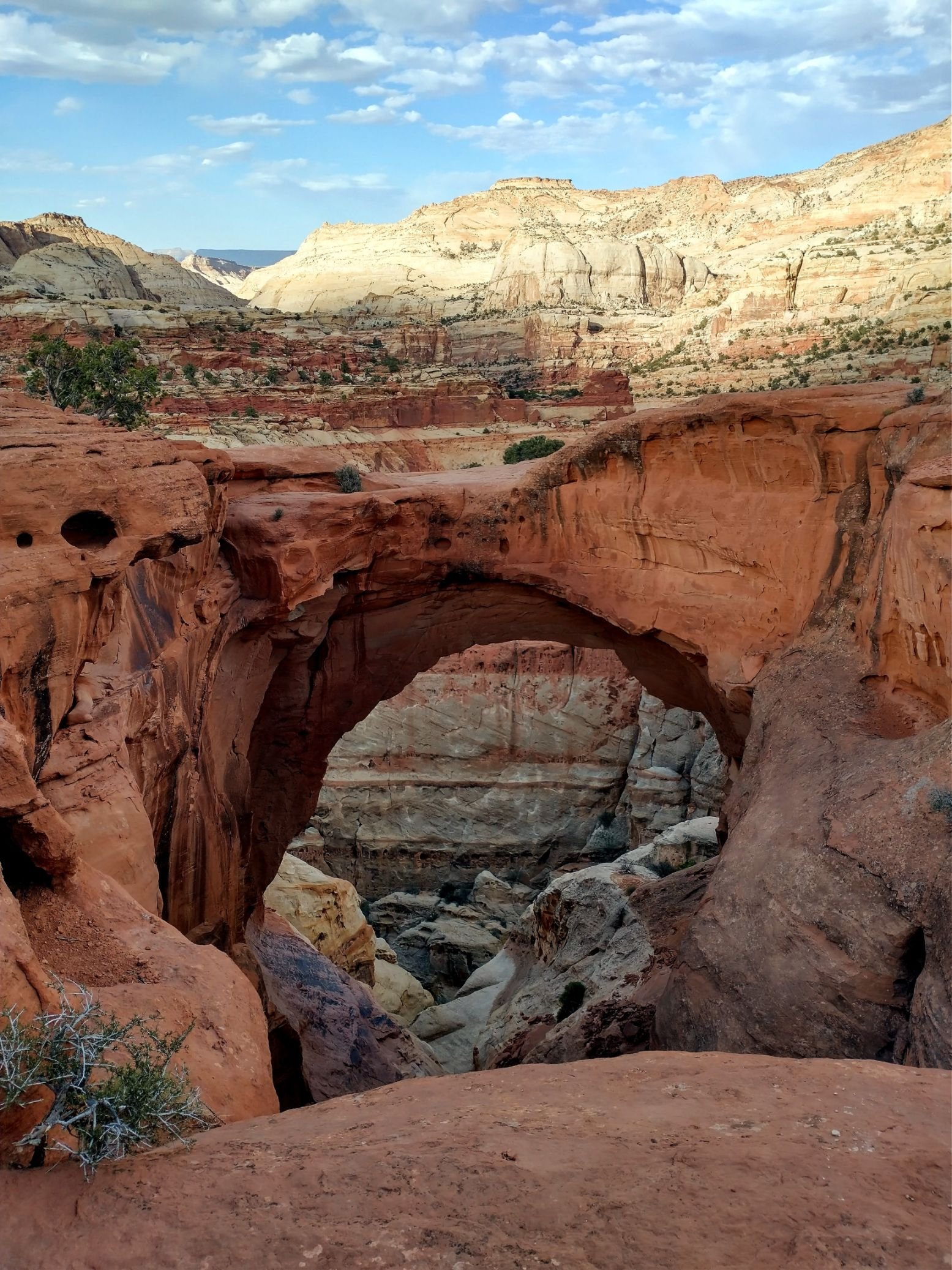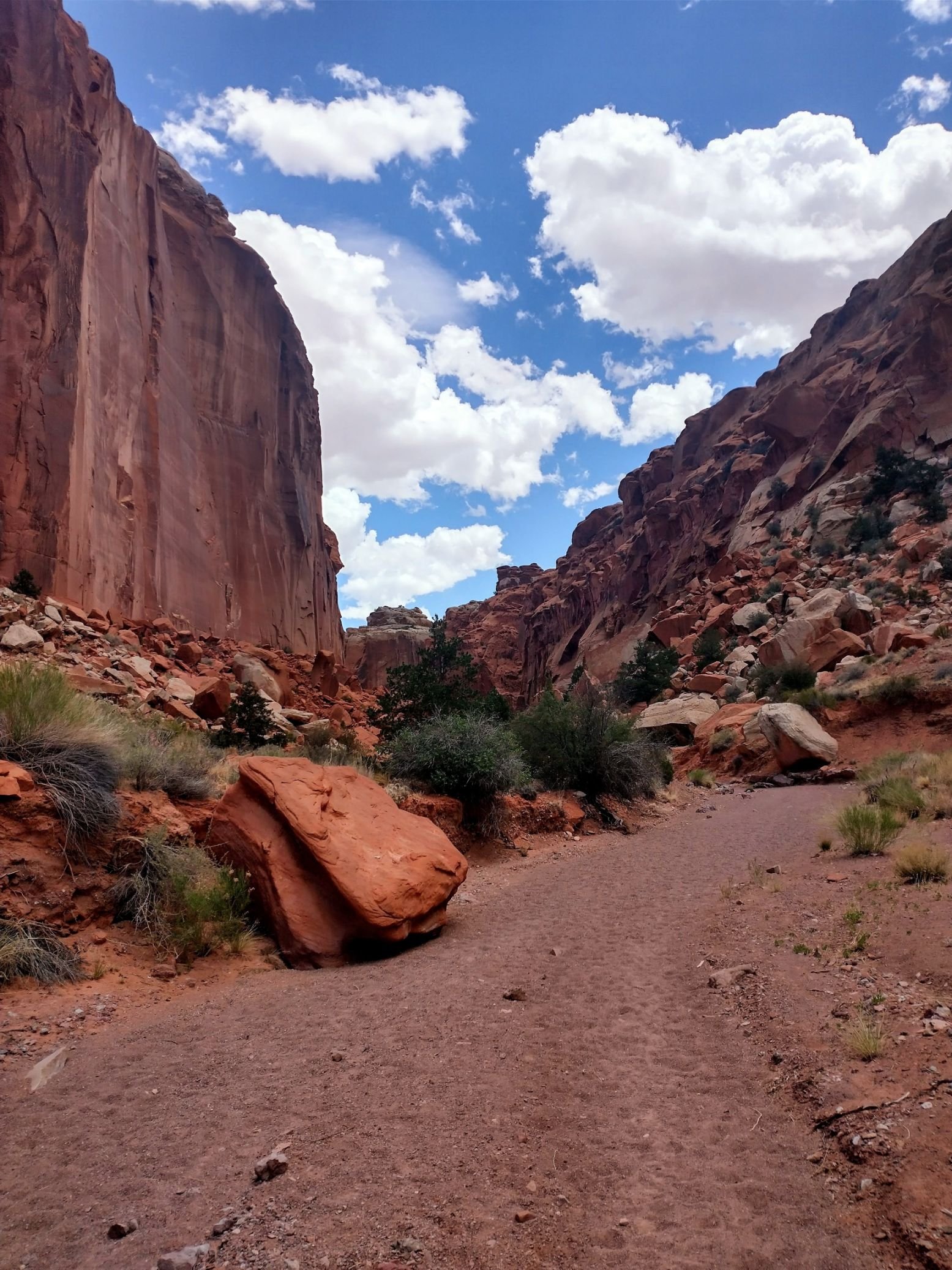Hiking Capitol Reef: Top Trails & Hiking Tips
If you ever visit Utah, hiking Capitol Reef should be at the top of your to-do list. And if you’re wondering what the hell Capitol Reef is, you’re about to find out how much you’ve been missing.
When people ask me what my favorite Utah National Park is, I tell them Capitol Reef. I get one of two different reactions: a kind of secret nod like “Oh, you know about Capitol Reef too?” or a completely blank stare. Usually it’s the blank stare, because most people have no idea what Capitol Reef is or where it’s located.
Capitol Reef National Park is one of the most overlooked National Parks…mostly because there are four other National Parks in southern Utah, all of which get more publicity. Part of the reason why Capitol Reef get less traffic is because it is far from the interstate or any major highways and is only accessible through scenic byways.
And you know what? That’s alright with me. Because one of my favorite aspects of hiking Capitol Reef is that it is much less crowded than Arches, Bryce Canyon, and Zion.
But you really don’t want to miss out on all the beauty that Capitol Reef has to offer, so let’s dive into my favorite hikes.
Cassidy Arch Hike
The Cassidy Arch hike is my favorite because of the stunning views. One of the things I like best about hiking Capitol Reef is that the whole hike is beautiful. You don’t have to hike a mile just to find a viewpoint or pretty rock formation. Instead, you pretty much get a good view along the entire length of the trail, so prepare to be amazed.
For a good portion of the hike you can see the gravel road below that leads to the Cassidy Arch trailhead. (Just be aware, it’s a pretty awful gravel road, but thankfully not very long.) From a few viewpoints, you can even see the parking lot below and snap a picture of your vehicle hundreds of feet below you.
As for Cassidy Arch itself…it’s pretty impressive. Just be careful not to fall through the arch!
Actually, the Cassidy Arch trail keeps you on your toes for most of the way, so be careful. The beginning portion of the trail is a steep and rocky climb. Then you turn a corner and you can suddenly see Cassidy Arch in the distance.
But the hike is far from over…because the Cassidy Arch trail doesn’t just take you to an arch viewpoint. It takes you behind the arch.
For the last leg of the hike, there is no trail at all. You will just be hiking over bare rock. You can’t even see the arch. Then, before you realize it, you will be standing right behind the arch looking through it.
If you want, you can walk over the arch as well. Or walk a little bit past the arch to another canyon overlook.
View of Cassidy Arch
Spring Canyon Trail
Spring Canyon trail isn’t a super popular hike, but it takes you down into a wash that threads through a very colorful canyon. You have to access the trail through the Chimney Rock Loop Trail (which is a more popular hike) or you can start from a trailhead along Hwy 24. The whole trail is about 10 miles long, but if you are sticking to shorter hikes you can always just go down a ways then come back. I suggest starting from the Chimney Rock trailhead, hiking the loop trail, then veering off into Spring Canyon.
Even on the more popular hikes like Chimney Rock, hiking Capitol Reef is crowd-free. Not only are there less park visitors than in most National Parks, but the trailhead parking is just too small. The Chimney Rock trailhead barely has parking space, so you don’t have to worry about sharing the trail with loads of people. On the other hand, just be aware that you might not be able to find room for your vehicle either.
Grand Wash
Can the Grand Wash really be called a trail? Eh, I don’t know about that. It really is just a huge wash that cuts through the national park. So, it’s about as easy as it gets when hiking Capitol Reef, because you don’t have any steep climbs. You can just stroll through the wash and gaze up at the canyon walls on either side.
The whole wash is about 7 miles long without much elevation gain, making it an easy trail that almost anyone can do.
Cohab Canyon
Cohab Canyon is hands-down where you want to go if you’re in the mood for climbing boulders and scaling canyon walls!
The canyon walls are riddled with holes that make perfect footholds and perches. We even found a couple short slot canyons hidden away in the rock walls.
Sure, the hike isn’t as impressive as some of the other trails in Capitol Reef, but hiking Capitol Reef is more fun when you can throw in a little bit of climbing.
Plus, the Cohab Canyon trail is super accessible. The trailhead is right across the road from the Fruita Campground, so if you are staying at the campground you don’t even have to drive anywhere. Just cross the street and start hiking!
The hike up from the campground to Cohab Canyon is a steep climb, but you get a pretty awesome view before descending into the canyon. The green areas below are the Fruita campground and orchard.
Hickman Bridge
If you’ve done any research on hiking Capitol Reef, then you have probably seen the Hickman Bridge trail listed as the most popular hike. As far as I know, it is the most popular…but that doesn’t mean it should be at the top of your list.
The Hickman Bridge trail is the most well-known simply because it has a reasonably-sized paved parking lot with bathrooms. Which may sound weird if you’ve never been to Capitol Reef…but most of the trailheads are either at small pullouts or down bumpy gravel roads that branch off of a long and narrow scenic drive.
The Hickman Bridge is just easily accessible. Sure, it’s a beautiful hike, but not nearly as stunning as the other trails I’ve listed in this post.
What to Know Before Hiking Capitol Reef
Before you get too excited about picking out trails in Capitol Reef, there are a few things you should know beforehand. These are just some tips I’ve picked up from hiking Capitol Reef, and they are helpful to keep in mind.
Prepare to be walking in sand. Many of Capitol Reef’s trails follow washes…which are mainly sand at the bottom. If you wear breathable tennis shoes, just know that you will have sand in your socks by the end of the hike.
A lot of the trails connect. It’s easy to get lost if you’re not careful, because many of the trails connect. For example, the Grand Wash connects to the Cassidy Arch trail, which connects to the Frying Pan trail, which takes you to the Cohab Canyon trail…are you confused yet? So, read the trail signs carefully, because you don’t want to start the Cassidy Arch hike and end up miles away at the campground (unless, of course, that’s your intention.)
Pay attention to rock markers. For most of the trails this isn’t a big issue, but there are a few places where you need to pay close attention to the rock markers. Without rock markers, I would have gone way off trail while hiking Cassidy Arch.
Watch out for flooding. Capitol Reef is crisscrossed with sandy washes and steep canyons, and as soon as it rains they fill with water. Don’t get caught in the rain during a hike! Even if you manage to hike back okay, you might be stuck in your vehicle for a while. The scenic drive, which contains the trailhead for Cassidy Arch and the Grand Wash, floods during a rain and becomes impassable. You may have to wait for the water to recede so you can motor through the mud and get back to the campground. It may sound like a highly improbably scenario…but I’ve seen it happen before.
Bring plenty of water. This one is pretty obvious. Capitol Reef is still in the desert, so bring lots of water and prepare for high temperatures when hiking Capitol Reef.
Use AllTrails to look at trail maps. If you want to see all of Capitol Reef’s hiking trails, I definitely recommend downloading the free AllTrails app to look at trail maps and ratings. Just be aware that you won’t have cell service in most of Capitol Reef, so if you want to download the trail maps to use in no-service areas, you will need to upgrade to AllTrails Pro.
Trust me; once you start hiking Capitol Reef, you won’t be able to stay away. It’s the kind of place you will want to return to again and again! With a wide variety of hikes for everyone, there is plenty to keep you coming back.
If you’re looking for more National Park advice, check out my blog on camping at Big Bend National Park.








